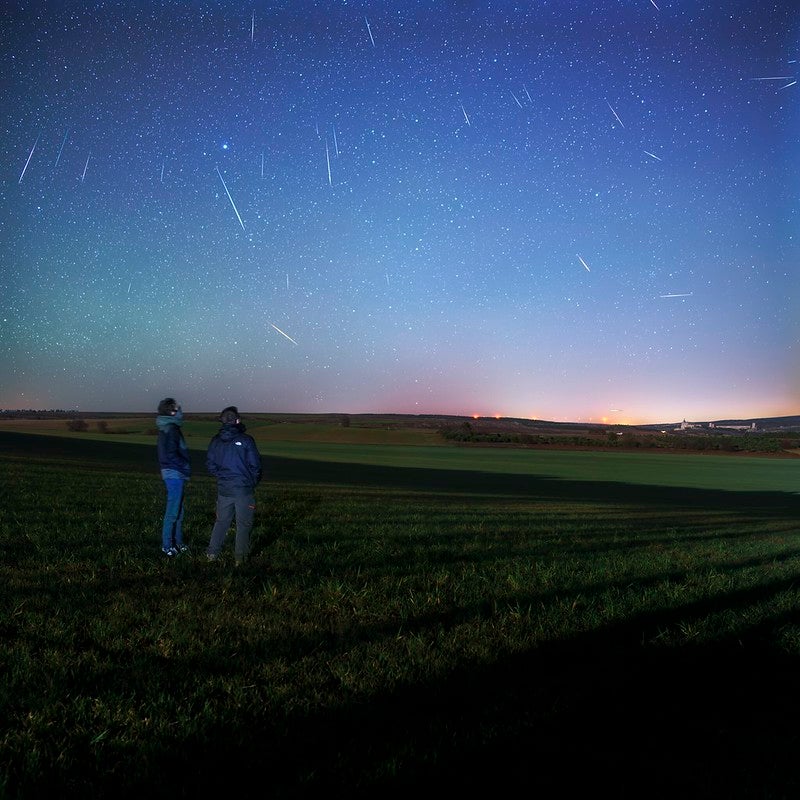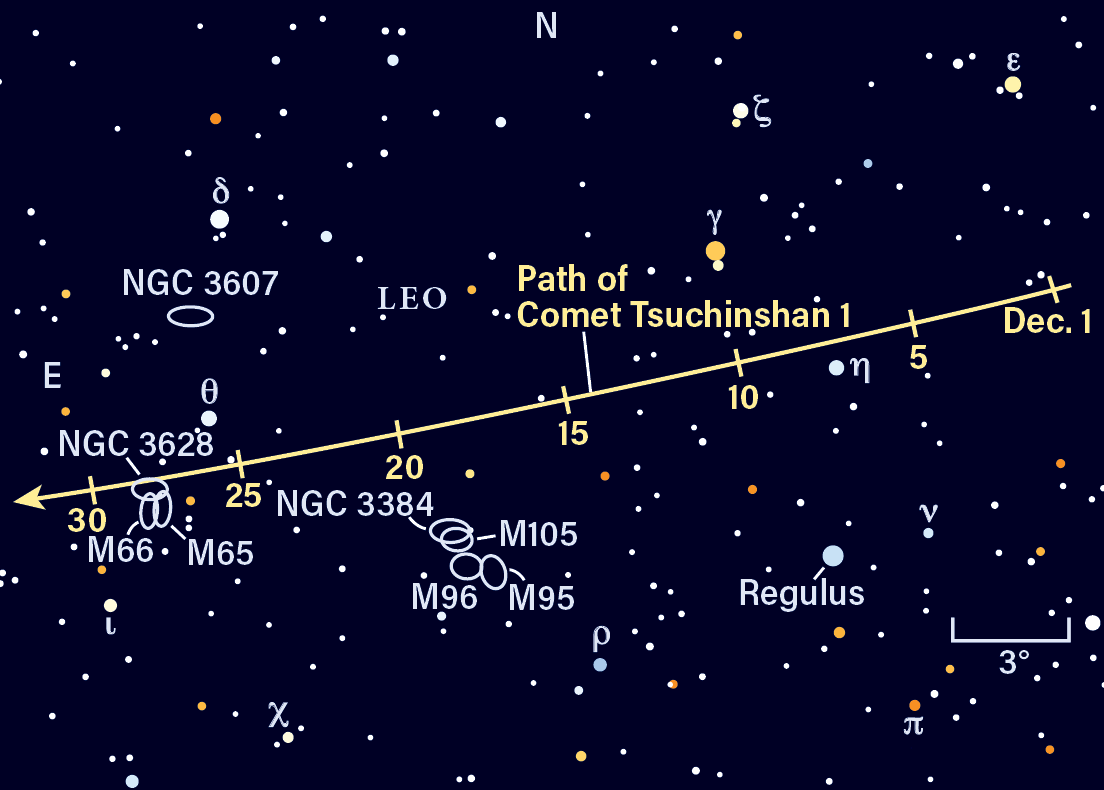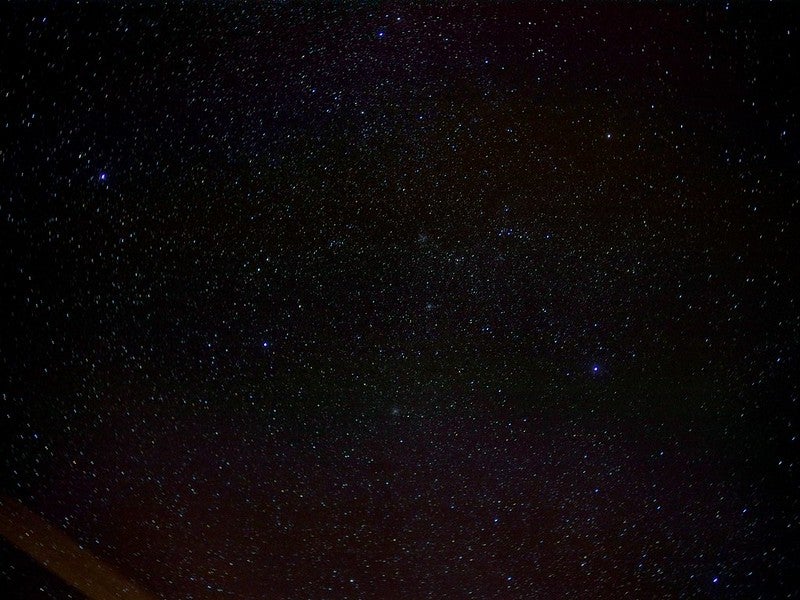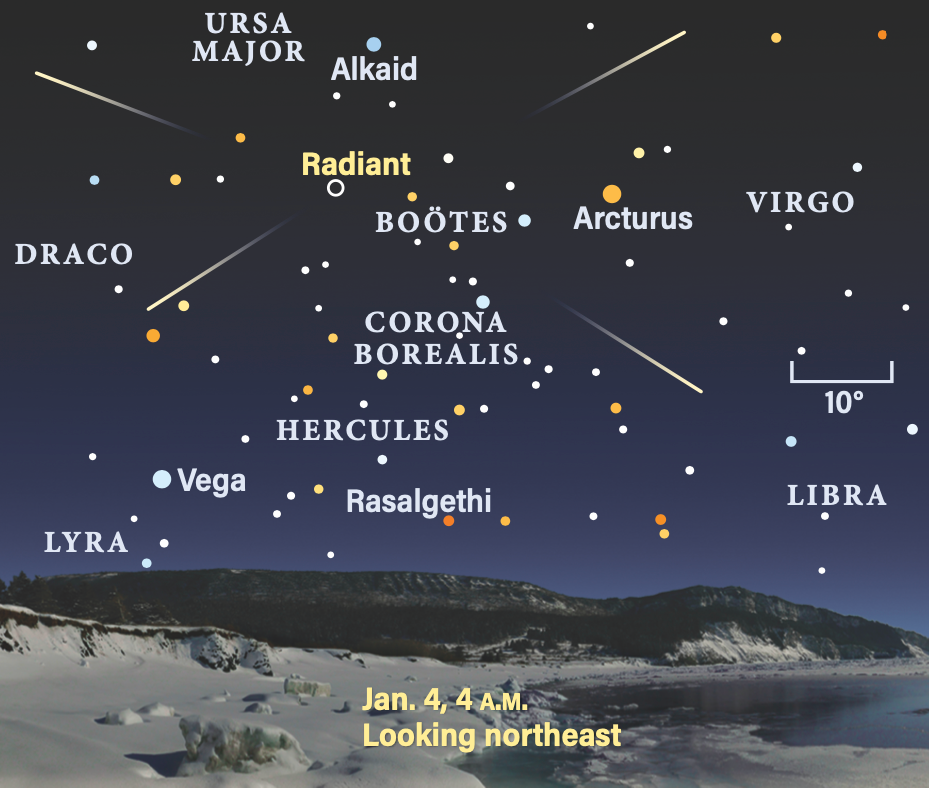
Friday, December 29
The next few weeks mark our last good views of Saturn as it begins to set earlier in the evening. By the end of January, the ringed planet will disappear below the horizon by about 7:30 P.M. local time.
For now, Saturn is still 30° high in the southwest an hour after sunset and sets around 9 P.M. local time. It glows at magnitude 0.9, making it easy to find amid the faint stars of Aquarius the Water-bearer. The nearest star with roughly the same magnitude lies to the lower left (south) of the planet — that’s 1st-magnitude Fomalhaut in Piscis Austrinus.
Saturn now sits about 12.5° south of Aquarius’ alpha star, 3rd-magnitude Sadalmelik. The planet spans about 16″ on the sky, with its rings reaching just over twice that width. As we go into 2024, it will also be your last chance to get a good view of the rings’ northern side before the next ring plane crossing, when they will “disappear” as we view them edge-on in 2025.
Also on view tonight is the planet’s largest moon, Titan, visible through binoculars or a telescope to Saturn’s northeast. Several smaller, fainter moons cluster closer to the planet, with Tethys and Rhea to the east and Dione to the west. All three of these are about 10th magnitude and can be captured with a telescope pretty easily once the sky is dark.
Sunrise: 7:22 A.M.
Sunset: 4:43 P.M.
Moonrise: 7:17 P.M.
Moonset: 9:38 A.M.
Moon Phase: Waning gibbous (93%)
*Times for sunrise, sunset, moonrise, and moonset are given in local time from 40° N 90° W. The Moon’s illumination is given at 12 P.M. local time from the same location.

Saturday, December 30
Although the Moon has begun to wane, it’s still bright as it hangs in western Leo. The bright background light will make our target this morning a bit of a challenge, but perhaps it’s one you’ll find worth the effort.
Comet 62P/Tsuchinshan 1 is passing near the famous Leo Trio (or Leo Triplet) of galaxies in the eastern end of the constellation this morning. Wait until an hour or two before sunrise, when the Lion is high in the south, to point your telescope toward Chertan, the 3rd-magnitude star in Leo’s back haunches. The Leo Trio, comprising the spiral galaxies M65, M66, and NGC 3628, lies just 2.5° southeast of this star. Tsuchinshan 1 is roughly 1.6° east-northeast of M66, the southeasternmost galaxy in the trio (and the brightest, by just a touch, at magnitude 8.9). M65 is magnitude 9.3 and about 20′ northwest of M66, while NGC 3628 is 35′ north of M66 and glows at magnitude 9.5. This last galaxy is hardest to see because it is the most edge-on to our line of sight, so some of its light is obscured by its dusty disk. That could even be why the other two made Messier’s catalog, but the third did not.
Even if you can’t observe the galaxies or comet visually with ease, astrophotographers will want to try for some longer-exposure photographs to capture the scene.
Sunrise: 7:22 A.M.
Sunset: 4:43 P.M.
Moonrise: 8:20 P.M.
Moonset: 10:07 A.M.
Moon Phase: Waning gibbous (87%)
Sunday, December 31
Jupiter ends the month standing stationary against the stars of Aries at 10 A.M. EST. This ends its retrograde loop; now the gas giant will begin moving east. The bright planet is visible all evening, rising before the Sun sets and setting around 2 A.M. local time. By an hour after sunset, it stands some 50° high in the southeast, above the magnitude 2.5 star Mekar in Cetus.
Early risers today can spot another bright planet standing above a bright star: Venus sits 10.5° above the famous red giant Antares in Scorpius today. Look for the two an hour (or slightly more) before sunrise — they are in the southeast, with Venus about 20° high and Antares some 8° above the horizon, directly below it. Venus is the clear winner in terms of brightness, shining at magnitude –4. Antares is still a bright star, though, at magnitude 1.1 — it the 15th brightest sun in our sky, in fact. You may be able to spot its brilliant red hue with your naked eyes; the color will certainly come through in binoculars or a telescope.
Under magnification, Venus appears 14″ wide and in a gibbous phase, some 78 percent lit. By tomorrow, the planet will close in on another of the Scorpion’s stars, standing less than 1° north of magnitude 2.6 Beta (β) Scorpii.
Sunrise: 7:22 A.M.
Sunset: 4:44 P.M.
Moonrise: 9:22 P.M.
Moonset: 10:31 A.M.
Moon Phase: Waning gibbous (80%)
Monday, January 1
The Moon reaches apogee, the farthest point from Earth in its orbit, at 10:28 A.M. EST this morning. It will then sit 251,599 miles (404,909 kilometers) away.
Following in Jupiter’s footsteps, Mercury is stationary today at 11 P.M. EST. The solar system’s smallest and speediest planet has started to pull away from the Sun; you might catch a brief glimpse of it in the morning sky about 30 to 40 minutes before sunrise, when it is some 8° high in the southeast and glowing at magnitude 0.5. You’ll need a clear horizon and likely binoculars to aid your search — make sure to put any optics away well before the Sun will rise from your location, which may differ slightly from the times given below.
Regardless of whether you can spot Mercury, you’ll certainly see Venus, still magnitude –4. A full hour before sunrise it is nearly 20° high and now less than 1° north of magnitude 2.6 Beta Scorpii.
Sunrise: 7:22 A.M.
Sunset: 4:45 P.M.
Moonrise: 10:21 P.M.
Moonset: 10:53 A.M.
Moon Phase: Waning gibbous (72%)

Tuesday, January 2
Did you know that our orbit around the Sun isn’t perfectly circular, but just slightly elliptical? Today, Earth reaches perihelion, the closest point to the Sun in its orbit around our star, at 8 P.M. EST. At that time, the Earth-Sun distance is just 91.4 million miles (147.1 million km). The average distance between the two is 93 million miles (150 million km) — this distance is defined as one astronomical unit, or AU. We’ll reach aphelion, Earth’s farthest point from the Sun, in early July.
Orion may get most of the attention in the winter sky, but it’s not the only constellation worth studying on chilly evenings. To the Hunter’s north is Auriga, a large, roughly circular constellation whose brightest star is magnitude 0.1 Capella. This constellation holds three Messier objects: all young, open clusters of stars. They are M36, M37, and M38.
M36 is a 12′-wide group of about 60 suns that shines at magnitude 6.3. It’s located just over 5.5° west-southwest of 3rd-magnutde Theta (θ) Aurigae, but it’s probably easier to locate by instead looking 6° northeast of bright magnitude 1.7 Beta Tauri, also called Elnath.
M37 lies about 3.7° east-southeast of M36. This next cluster is just a touch fainter (magnitude 6.2) but twice as wide and contains more than eight times as many stars.
Finally, let’s jump to M38, which sits 2.3° northwest of M36. This is the faintest of the three at magnitude 7.4, though its nearly as wide as M37.
Sunrise: 7:22 A.M.
Sunset: 4:46 P.M.
Moonrise: 11:20 P.M.
Moonset: 11:13 A.M.
Moon Phase: Waning gibbous (63%)
Wednesday, January 3
Last Quarter Moon occurs at 10:30 P.M. EST. Because the Moon won’t rise until after midnight, this evening is a great time to enjoy one of the wintertime sky’s most stunning sights: the Orion Nebula (M42).
This huge, active star-forming region is visible to the naked eye as a slight fuzzy patch around what appears to be a single star of magnitude 4.7, which lies just below (south-southwest) of the easternmost star in Orion’s Belt, magnitude 1.7 Alnitak.
But this magnitude 4.7 star is actually four stars crammed into a space just 22″ apart; these are the stars of the Trapezium Cluster, visible with any small telescope. Surrounding them is the gauzy haze of the Orion Nebula, which stretches nearly 1.5′ at its widest and glows at magnitude 4. Its gases have birthed and are now being sculpted by the bright stars of the Trapezium, as well as many other suns still embedded within the nebula.
Take some time with this object however you are observing it — with binoculars, a telescope, or by taking images. This breathtaking region of stellar birth and evolution is a treasure trove for astronomers seeking to understand the life cycles of stars and the clouds they grow from, and it also paints a beautiful picture in the cold, dark winter sky that everyone can enjoy.
Sunrise: 7:22 A.M.
Sunset: 4:47 P.M.
Moonrise: —
Moonset: 11:33 A.M.
Moon Phase: Waning gibbous (54%)

Thursday, January 4
The Quadrantid meteor shower peaks this morning, with the best viewing opportunities in the few hours of darkness before dawn. The maximum zenithal rate for this year’s Quadrantids is expected to be around 80 meteors per hour, though this rate is calculated for a time when the shower radiant is directly overhead. It won’t be that high early in the morning, so observers should expect rates closer to 25 to 30 meteors per hour — still well above the sporadic background rate (which is just a few meteors per hour on nights when there is no shower).
The Quadrantids’ radiant sits in an area of the sky now claimed by Boötes the Herdsman. It is some 60° high in the east about 90 minutes before sunrise, about 30° to the left of the bright red giant Arcturus, Boötes’ brightest star. Other bright stars in the area include Vega and Deneb, both closer to the horizon.
This shower is named for the now-defunct constellation Quadrans Muralis, which was first created in 1795. It did not survive the 1922 adoption of the modern constellations by the International Astronomical Union, which gave us the 88 official star patterns we recognize today.
The Quadrantid meteor shower is known for producing the occasional fireball, or particularly bright meteor, so keep an eye out for these as you try to stay warm on this chilly early January morning. Although the Moon hangs in the morning sky as well, it is a thin crescent in the south that won’t interfere with the shower much.
Sunrise: 7:22 A.M.
Sunset: 4:48 P.M.
Moonrise: 12:20 A.M.
Moonset: 11:53 A.M.
Moon Phase: Waning crescent (44%)
Friday, January 5
Tonight’s wintry target is both easy and a challenge. Why? Because it is bright but also far to the south, failing to rise very high for U.S. observers in the northern half of the country.
We’re looking for the Snow Collar Galaxy (NGC 1291), a magnitude 8.5 spiral galaxy in Eridanus the River. Around 8 P.M. local time, this galaxy is as high as it gets above the southern horizon, sitting 3.7° east of magnitude 3.5 Theta Eridani. This region is to the lower right of Orion as he stands upright about this time, aiming his curved bow of stars at Taurus the Bull.
Even a small telescope will show this spiral as a slightly oblong glow stretching about 10.5′ across. But you’ll need a large scope to discover why its name is the Snow Collar: The galaxy sports two faint arcs of light that Astronomy columnist Stephen James O’Meara says look like snowflakes perched on a jacket’s fur collar. Astroimagers should have some luck resolving these in deep images.
Sunrise: 7:22 A.M.
Sunset: 4:49 P.M.
Moonrise: 1:21 A.M.
Moonset: 12:15 P.M.
Moon Phase: Waning crescent (35%)

Sky This Week is brought to you in part by Celestron.









